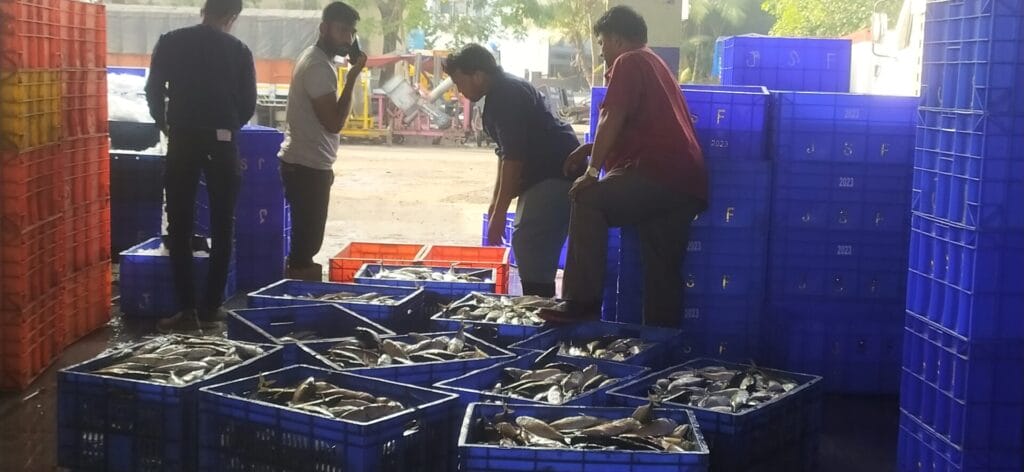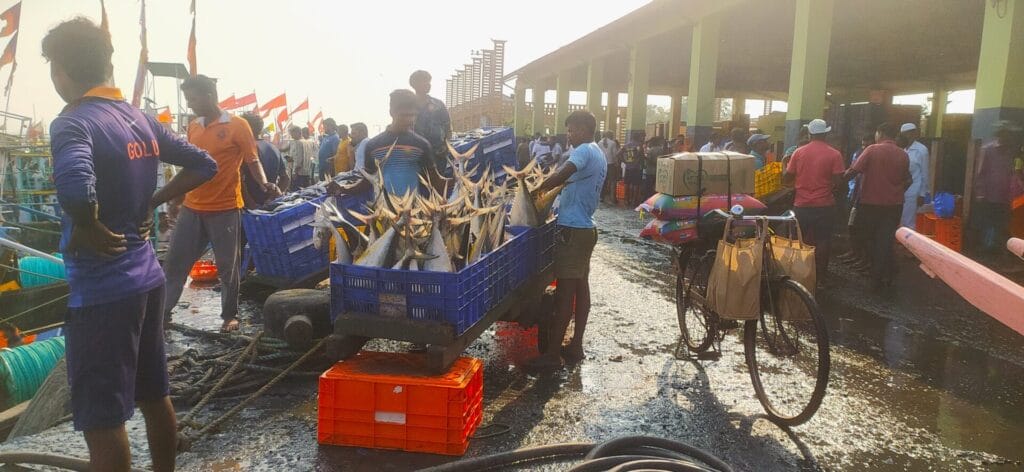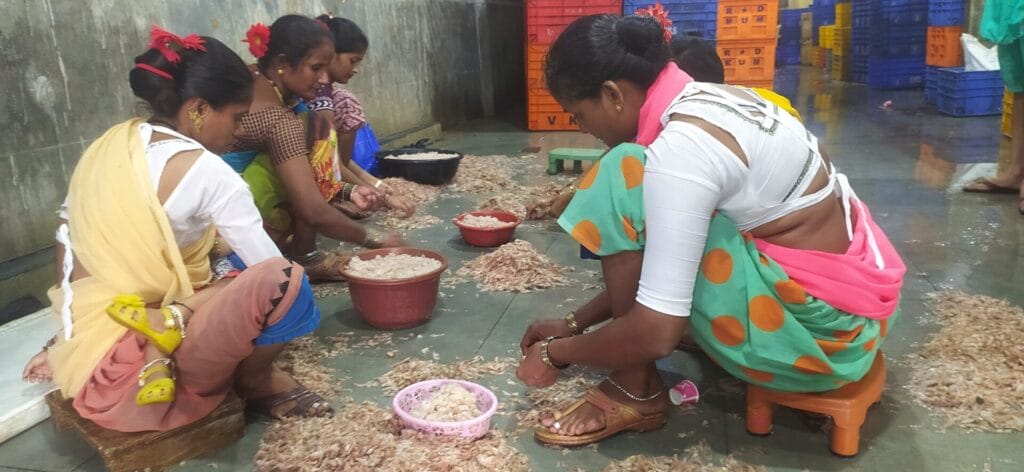The 148-year-old Sassoon docks, located at Mumbai’s southernmost tip is set for a complete revamp to get rid of the foul smell emanating from the docks.
The docks were developed as a sea port over a century ago by Albert Abdul Sassoon, then a prominent textile trader. Today, it is Mumbai’s oldest and biggest wholesale fishing harbour with an estimated daily fish catch of 150 tonnes brought in by around 600 registered boats.
The Mumbai Port Authority (MbPA), is the governing body of the 60,000 sq meters-huge dock (3.7 hectares of old dock and 3.8 hectares of new dock). It has asked the Kochi-headquartered National Institute of Fisheries Technology (NIFT) to suggest remedial measures at Sassoon to improve fish handling and processing to reduce foul smell emanating from the docks.
Shellfish waste and stench
In its preliminary findings, the NIFT found that the stench prominently emanated from the decayed fish and mishandled fish waste of shell fishes like prawns and shrimps. “While other kinds of fish are directly taken out to the cold storages for exporting, prawns are sorted, de-shelled here in a big way. The prawn waste is what leads to the stench as it lies decaying in the dump,” explained Pramod Pawle, chairman of the Sassoon dock Seafood Suppliers Association.
Also, cleaning and de-shelling of prawns is a huge operation involving many unorganised labourers, who do not handle the prawns hygienically nor dispose of the fish waste systematically adding to the stench, he added.
“The big traders buy prawns in bulk and employ large numbers of labourers to clean them in various units within the docks. Then there are some traders, who buy prawns at an individual level, clean them somewhere within the docks and then sell the de-shelled prawns at a higher margin,” explains Pramod, who has been dealing with fish from the docks for over three decades and has pursued issues and policies regarding fishers.

Read more: Why fishermen in suburban Mumbai find their catch shrinking steadily
Impact of poor handling on quality
In their initial survey conducted from May to August 2023, the NIFT team found that the process of decaying had set in right from the time the fish landed at the harbour.
It also found that the catch had traces of bacteria in fish because of poor handling. They found that the fish decayed faster because adequate ice wasn’t used in the storage process. It reduced its shelf life, quality, nutritional value and even market value.
The NIFT has recommended higher quantity of ice usage for storage (in 1:1 proportion, for example one kg of ice for 1 kg of fish). Recommendations include maintaining professional standards such as use of gloves for handling the fishes, use of tables for keeping fish (and not on the ground), air-conditioned units for cleaning and treatment of the fish waste water before releasing it so as to not to pollute other water bodies.
These measures are currently followed in Kerala.
“Studies found that the fishes were laced with bacteria and had reduced protein quotient due to unhygienic handling of fish at the docks. We would like the workers to work in healthy conditions as well as for consumers to get healthy fish,” says Atul Patne, state fisheries commissioner.
Incidentally, this isn’t the first attempt to deal with the stench. Four years ago the MbPA set up a fish waste processing plant with a capacity to handle 40 metric tonnes of waste daily. However, people continued to dump their waste at regular garbage systems rather than hand it over to them. The plant runs at half of its capacity today, inform Mumbai Port Trust officials. The NIFT has now suggested utilisation of secondary seafood waste plant for development of value added products like chitin and chitosan.
Over all improvement of docks
Since a majority of the fish handling and cleaning is being done by individual workers, hands-on training is also on the cards. The workers were shown films about the fish handling and processing industry at Kochi. Some workers could also be taken to Kochi to study fish handling practices.

George Ninan, director of CIFT, feels that a lot rides on the remodelling and redevelopment of the Sassoon docks. “When India is unable to maintain quality of fishes, it impacts the export revenue and India’s international reputation as a fishing exporter,” says George. Currently, India is the third largest exporter of fishes in the world with frozen shrimp topping the list.
Chairman of MbPA Rajiv Jalota says that Sassoon docks must be developed into a world class fishing harbour by introducing scientific methods of fish handling, waste processing and working on reducing fish decomposition and wastage. This will ensure a cleaner and stench-free harbour that will attract tourists and buyers and provide relief to local residents.
Women workers and waste disposal
Another cause of stench is the drainage lines clogged with fish waste.
Local corporator from Colaba, Makarand Narvekar says that he regularly gets complaints about drainage lines being blocked. His solution – get peeling activity done at a dedicated space rather than have it spread all over.
“Most of the labourers involved in the fish peeling work are women from Gulbarga district of Karnataka. If they are provided with a proper place to peel their fish, it will help proper waste disposal. The MbPA should also consider providing facilities like toilets, resting place and even crèche for the women labourers, free of cost, as part of the overall Sassoon redevelopment plans,” feels Makarand. “Currently, the women have no place to rest and can be seen sitting and eating their meals anywhere, even on the sides of the streets,” he observes.
“The women involved in peeling were granted a space earlier but it was closed due to a minor slab collapse. Even though many units lie vacant, they are not made available to us. The women peelers are poor and earn a pittance of hardly Rs 25 per kilo of prawns and cannot afford to pay for any facility. Hence, the authorities must provide free facilities for them,” says Dhanraj Pawar from the Jai Sewalal Sassoon Dock Asangathit Kamgar Association,

Citizens’ voices
Local residents of Colaba, who have borne the brunt of this fish stench for long, hope that the issue of stench would finally be resolved. The residents had moved the Bombay High Court in April 2023 demanding action against stench from Sassoon docks. They demand that fish waste be processed within the dock and not allowed to be ferried in open trucks thus spilling the dirty liquid waste water (leachete) over the streets spreading a stench in the entire area. It also demanded to stop the fish retailing activity and prawns peeling work on the footpaths outside the docks.
“While we are happy to see things move on this, we will prefer to wait and see how and when it actually gets implemented” says Tripti Narula, one of the petitioners demanding action against the fish stench.
In its interim order, the Bombay High Court had remarked that the modernisation of the dock would be essential for mitigating the pollution being caused by the solid waste accumulating everyday on account of fishing activity at the Sassoon docks.
Sassoon docks modernisation plan
The long-pending modernisation plan involves air-conditioned fish markets with auction halls, ice factory, additional space for trawlers to unload the catch of the day using conveyor belts. Apart from that there will be a museum with a library and visual center, a food court, an amphitheater and multi-cuisine restaurants with parking facilities. The project was stalled due to budgetary issues but is now back on track and the results should be seen in a few years time, says Atul.
There have been parallel initiatives like a Mumbai Art festival with murals and art installations to attract tourists and citizen engagement.
The dock continues to be popular attracting about 40,000 visitors daily including workers and buyers.
Colaba resident Samuel Christudoss, a regular at Sassoon, says he prefers to buy at the docks because of wholesale pricing and wide variety of fishes. “Surprisingly, the air inside the dock is much better than on the roads outside, where the stench is unbearable almost throughout the day. I do notice improved clean-ups these days,” says his wife Prabhavathy Christudoss.
Stench-free Sassoon docks with adequate and excellent fish handling systems will be a win-win for fisherfolk, residents and visitors too.
| Have you been to Sassoon docks? For buying fish or just to walk around this iconic place? What was your experience? Please share with us at mumbai@citizenmatters.in. |